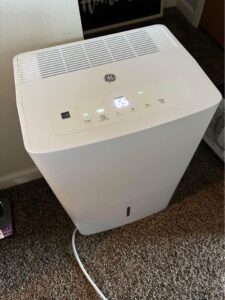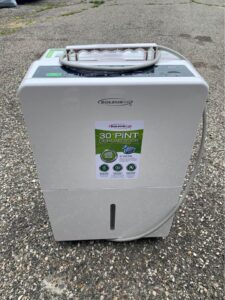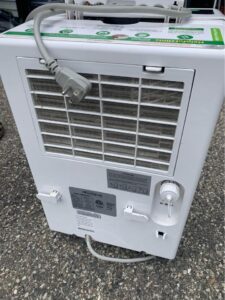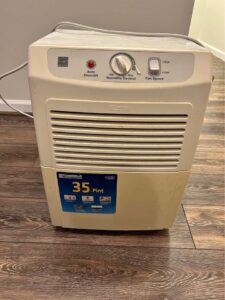Mobile Home Dehumidifiers: Complete Moisture Control Guide
Say goodbye to dampness, mold, and musty odors with the right dehumidifier. Expert sizing guide and Amazon products for healthier mobile home living.
Moisture Prevention
Stop mold & mildew
Expert Sizing
Perfect fit guarantee
Amazon Products
Best models delivered
30+ Years Experience
1,000+ homes helped
Mobile Home Moisture Problems & Solutions
Understand the unique moisture challenges mobile homes face and how dehumidifiers solve them
⚠️ Common Moisture Problems
- Mold and mildew growth
- Musty odors throughout home
- Condensation on windows
- Warped floors and walls
- Allergies and respiratory issues
- Damaged furniture and belongings
✅ Dehumidifier Benefits
- Prevents mold and mildew
- Eliminates musty odors
- Reduces condensation
- Protects home structure
- Improves air quality
- Creates comfortable living
⚠️ Why Mobile Homes Need Special Attention
Mobile homes are more susceptible to moisture issues due to limited airflow, construction materials, and space constraints. The EPA reports that mobile homes can have humidity levels 20-30% higher than traditional homes without proper moisture control.
Top Mobile Home Dehumidifiers - Delivered to Your Door
Professional-grade dehumidifiers we recommend based on 1,000+ mobile homes experience
🥇 Frigidaire 70-Pint Dehumidifier
✅ Energy Star certified
✅ Auto-defrost function
✅ Continuous drain option
🏠 50-Pint Energy Star Dehumidifier
✅ Ultra-quiet operation
✅ Digital humidity display
✅ Auto shut-off protection
🚚 Portable 30-Pint Dehumidifier
✅ Easy mobility with wheels
✅ Compact design
✅ Affordable moisture control
💨 Whole-House Dehumidifier
✅ Maximum coverage
✅ Professional installation
✅ Ultimate moisture control
🔧 Dehumidifier Accessories Kit
✅ Replacement filters
✅ Humidity meters
✅ Installation hardware
❄️ Desiccant Dehumidifier
✅ No ice buildup issues
✅ Extremely low temperatures
✅ Energy efficient operation
Mobile Home Dehumidifier Sizing Guide
Choose the perfect capacity for your mobile home size and moisture conditions
| Mobile Home Size | Square Footage | Recommended Capacity | Ideal for | Amazon Option |
|---|---|---|---|---|
| Single Wide (Small) | 400-700 sq ft | 30-40 Pint | Bedrooms, living areas | Shop 30-Pint |
| Single Wide (Large) | 700-1,000 sq ft | 50-60 Pint | Whole home coverage | Shop 50-Pint |
| Double Wide | 1,000-1,500 sq ft | 70-90 Pint | Large homes, high moisture | Shop 70-Pint |
| Triple Wide | 1,500+ sq ft | 90+ Pint or Multiple Units | Large families, extreme moisture | Shop 90-Pint |
✅ Pro Tip from 30+ Years Experience
For mobile homes in humid climates (like Michigan lake areas), choose the next size up. It's better to have slightly more capacity than not enough. The Department of Energy recommends maintaining 30-50% relative humidity for optimal comfort.

Portable Dehumidifier
Perfect for single rooms and targeted moisture control

Energy Star Certified
Look for this label to ensure maximum efficiency and savings
Mobile Home Dehumidifier Setup & Placement
Expert installation tips for maximum effectiveness and safety
Choose Central Location
Place dehumidifier in a central area for maximum air circulation. Avoid corners or areas blocked by furniture.
✅ Away from walls and furniture
ℹ️ Consider multiple units for large homes
Ensure Proper Ventilation
Maintain 6+ inches clearance around unit. Never block air intake or exhaust vents for optimal performance.
✅ 6-inch minimum clearance
✅ Check manufacturer specs
Power and Drainage Setup
Use dedicated outlet, avoid extension cords. Set up continuous drainage or plan regular tank emptying.
Set Optimal Humidity Level
Start at 45% relative humidity and adjust based on comfort and condensation levels. Monitor with built-in meter.
✅ Start at 45% setting
✅ Adjust seasonally

Power & Drainage Setup
Proper electrical connection and drainage configuration

Regular Maintenance
Clean filters and tanks for optimal performance and longevity
How to Reduce Moisture in Your Mobile Home
Comprehensive strategies beyond dehumidifiers for complete moisture control
🍳 Kitchen Moisture Control
Use exhaust fans while cooking, cover pots when boiling, and open windows when weather permits.
- Run exhaust fan during and after cooking
- Cover pots and pans when boiling
- Use lids on slow cookers and rice cookers
- Wipe down surfaces after meal prep
🚿 Bathroom Humidity Management
Essential for preventing mold in mobile home bathrooms with limited ventilation.
- Use bathroom exhaust fan during showers
- Leave fan running 30 minutes after
- Open bathroom door when safe to do so
- Squeegee shower walls after use
👕 Laundry Best Practices
Proper clothes drying prevents massive moisture release into your mobile home.
- Always vent dryer outside
- Check dryer vent for clogs monthly
- Hang clothes outside when possible
- Use dehumidifier in laundry area
✅ Structural Improvements
Address root causes of moisture infiltration for long-term solutions.
- Seal cracks around windows and doors
- Improve insulation in problem areas
- Fix plumbing leaks immediately
- Upgrade to better ventilation systems
⚠️ Watch for These Moisture Warning Signs
Condensation on windows, musty odors, visible mold, peeling wallpaper, or increased allergy symptoms. The CDC warns that dampness and mold can cause serious health issues, especially in mobile homes with poor ventilation.
Mobile Home Dehumidifier FAQs
Expert answers from our 30+ years of mobile home experience
Size depends on square footage and moisture levels. For single-wide mobile homes (400-1,000 sq ft), choose 30-50 pint capacity. Double-wide homes (1,000-1,500 sq ft) need 50-70 pint units. In high-humidity areas like Michigan lakefront, go one size larger. The Energy Star program provides detailed sizing guidelines for optimal efficiency.
Run continuously during humid seasons (typically spring through fall in Michigan). Mobile homes trap moisture more than traditional homes, so consistent operation is crucial. Use auto-humidity settings to maintain 40-50% relative humidity. In winter, you may only need occasional use unless you have specific moisture problems.
Yes, standard household dehumidifiers work perfectly in mobile homes when properly sized. The key is choosing the right capacity for your space and ensuring adequate ventilation around the unit. Avoid basement-specific models unless you have an actual basement or large crawl space.
Place in a central location away from walls and furniture for maximum air circulation. Common effective locations include the main hallway, central living area, or largest room. Ensure 6+ inches clearance on all sides and access to a dedicated electrical outlet. The HUD mobile home guidelines emphasize proper ventilation for moisture control.
Dehumidifiers prevent new mold growth by maintaining proper humidity levels, but existing mold must be cleaned first. Maintain humidity below 50% to prevent mold. For severe mold problems, professional remediation may be needed before dehumidifier installation. The EPA provides guidelines for safe mold cleanup.
Refrigeration dehumidifiers (most common) use cooling coils to condense moisture and work best in temperatures above 60°F. Desiccant models use moisture-absorbing materials and work better in colder conditions. For most mobile homes, refrigeration units are ideal and more energy-efficient.
Moisture Problems Overwhelming? We Can Help!
Dealing with severe mold, structural moisture damage, or just tired of the constant battle? We buy mobile homes in any condition across Michigan, Ohio, and Indiana.
Fast Cash Offers
Even with moisture issues
Any Condition
Mold, structural damage OK
Free Moving
We handle all logistics
No Repairs Needed
Sell as-is today
Call/Text: (989) 233-2568 | Available 7 Days a Week
Related Mobile Home Maintenance Articles
More expert guides from our 1,000+ mobile home experience
Mobile Home Dryer Vent Cleaning
Prevent fires and improve efficiency with proper dryer vent maintenance.
Read GuideMobile Home Furnace Maintenance
Complete heating system maintenance and repair guide for mobile homes.
Read GuideMobile Home Maintenance Checklist
Complete maintenance schedule to keep your mobile home in top condition.
Read GuideCreate a Healthier Mobile Home Environment
Proper moisture control with the right dehumidifier transforms your mobile home into a comfortable, healthy living space. Use our sizing guide and Amazon recommendations to find the perfect solution for your needs.
✅ Take Action Today
Don't let moisture issues damage your home or health. Invest in proper dehumidification and enjoy the benefits of cleaner air and a more comfortable living environment.
Questions? Call Our Mobile Home Experts
